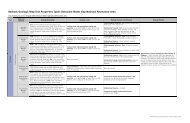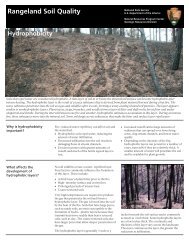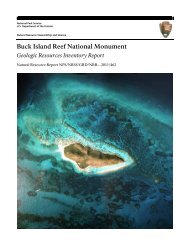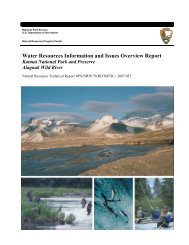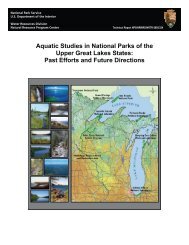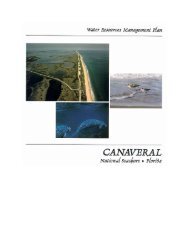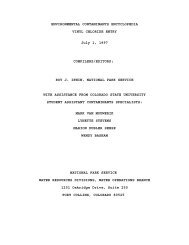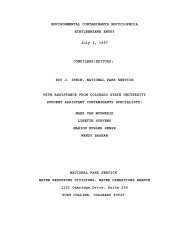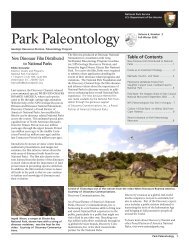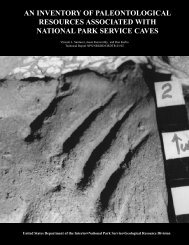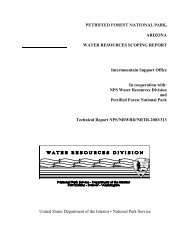toluene - National Park Service
toluene - National Park Service
toluene - National Park Service
Create successful ePaper yourself
Turn your PDF publications into a flip-book with our unique Google optimized e-Paper software.
C) Body Burden Residues in Humans: Typical, Elevated, or<br />
of Concern Related to the Well-being of Humans:<br />
All 8 samples of mothers' milk from 4 urban areas<br />
were positive(1). Human blood, 250 specimens, 100%<br />
pos, 0.2-38 ppb, 1.5 ppb avg(2). US FY82 <strong>National</strong><br />
Human Adipose Tissue Survey specimens, 46<br />
composites, 91% pos, (>1 ppb, wet tissue concn),<br />
250 ppb max(3). [(1) Pellizzari ED et al; Bull<br />
Environ Contam Toxicol 28: 322-8 (1982) (2) Antoine<br />
SR et al; Bull Environ Contam Toxicol 36: 364-71<br />
(1986) (3) Stanley JS; Broad Scan Analysis of the<br />
FY82 <strong>National</strong> Human Adipose Tissue Survey Specimens<br />
Vol. I Executive Summary p. 5 USEPA-560/5-86-035<br />
(1986)] [609].<br />
Tis.Misc. (Other Tissue Information):<br />
No information found.<br />
Bio.Detail: Detailed Information on Bioconcentration,<br />
Biomagnification, or Bioavailability:<br />
Bioconcentration factors (BCFs) for <strong>toluene</strong> in biota have been<br />
predicted to be between 15 and 70 (values less than 100 generally<br />
indicate that a compound is unlikely to undergo significant<br />
bioconcentration in organisms or biomagnification along food<br />
chains) [866].<br />
Some bioconcentration factors (log BCF) are [902]: 1.12 for<br />
eels, 0.22 for Manila clam, 0.62 for mussels, 2.17 for<br />
microorganisms in water, 0.92 for goldfish, 2.58 for algae, 1.95<br />
for fish, and 0.89 also for fish. General BCF in l/kg: 10.7<br />
[689]. In humans, <strong>toluene</strong> is absorbed from the lungs and to some<br />
extent through the skin; inhaled <strong>toluene</strong> was not excreted rapidly<br />
enough to be completely eliminated with 24 hours, in a study on<br />
human volunteers [606].<br />
Based on its lipophilic properties, <strong>toluene</strong> is expected to<br />
have a moderate tendency to bioconcentrate in the fatty tissues of<br />
aquatic organisms. The bioconcentration factor was estimated to be<br />
about 10.7 in fish and about 4.2 in mussels. The levels that<br />
accumulate in the flesh of aquatic species also depend on the<br />
degree to which the species metabolize <strong>toluene</strong>. The highest tissue<br />
levels of <strong>toluene</strong> tend to occur in species such as eels, crabs, and<br />
herring that have a low rate of <strong>toluene</strong> metabolism [904].<br />
Metabolism of <strong>toluene</strong> limits its tendency to biomagnify in the<br />
food chain [904].<br />
Bioconcentration [609]:<br />
BCF: eels (Anguilla japonica, 13.2(1); Manila clam (Tapes<br />
semidecussta), 1.67(2); mussel (Mytilus edulis), 4.2(3); algae



